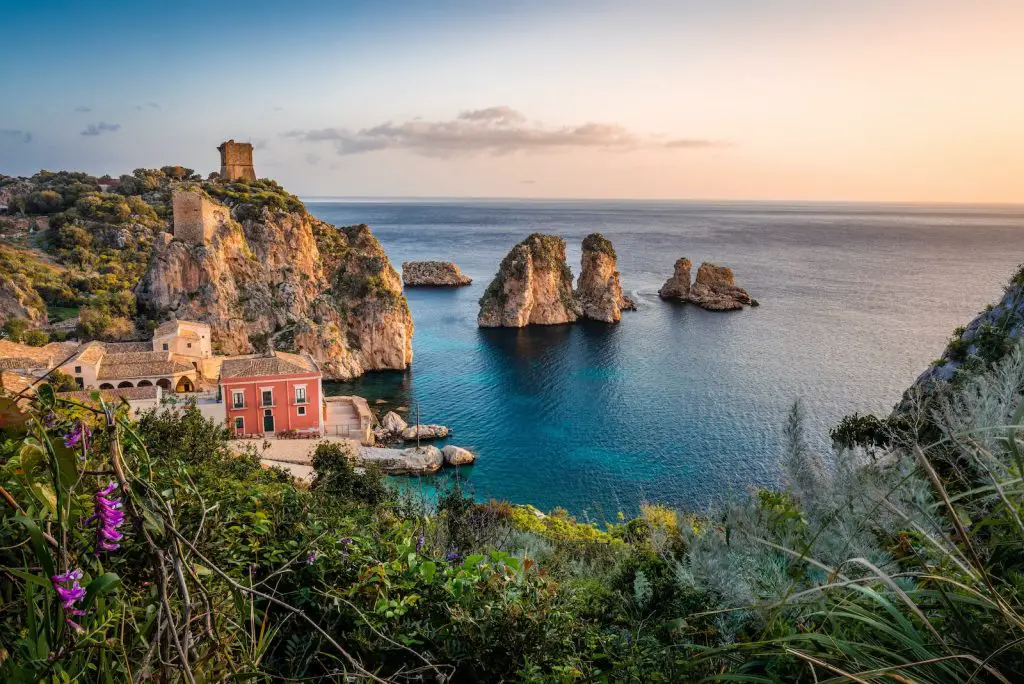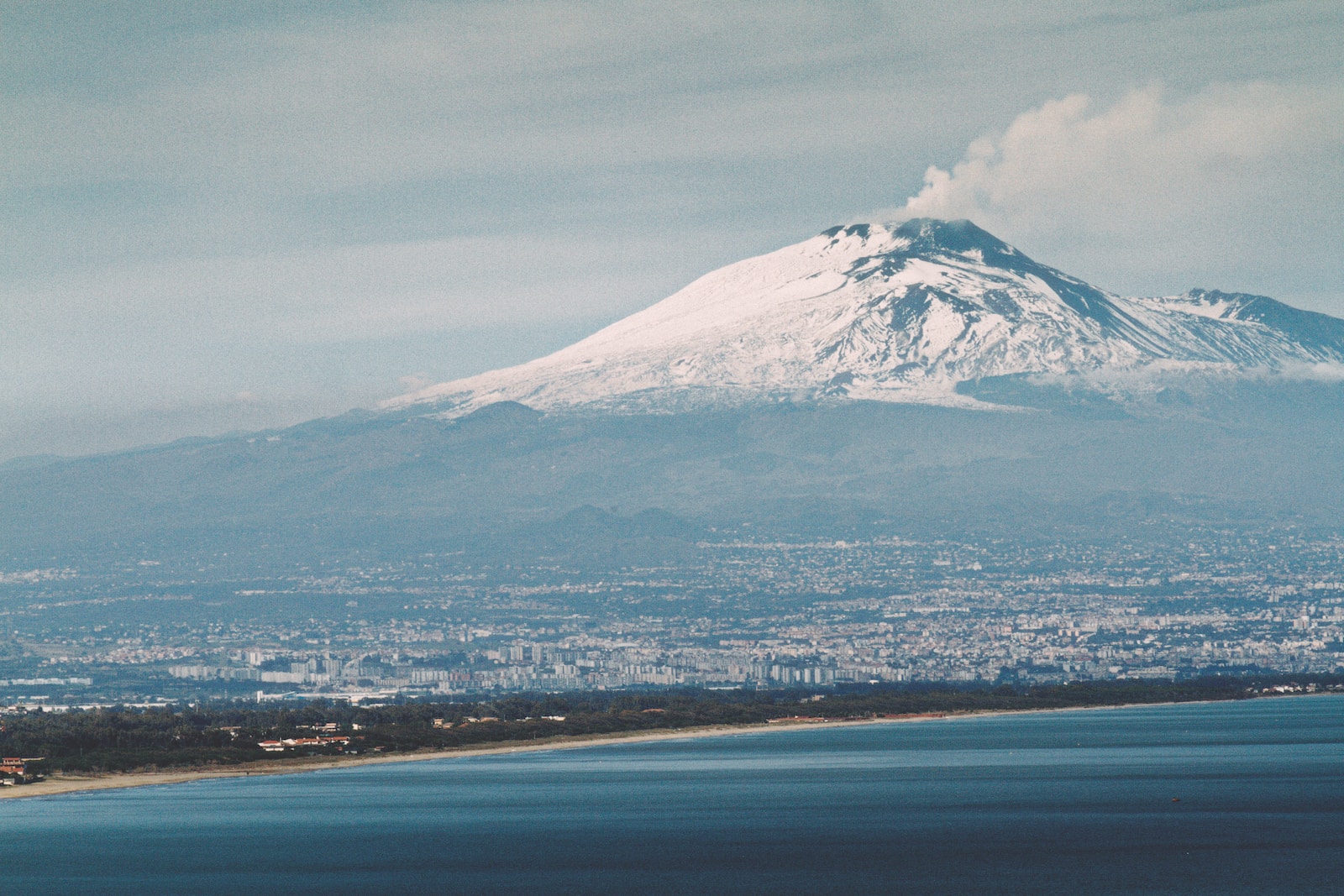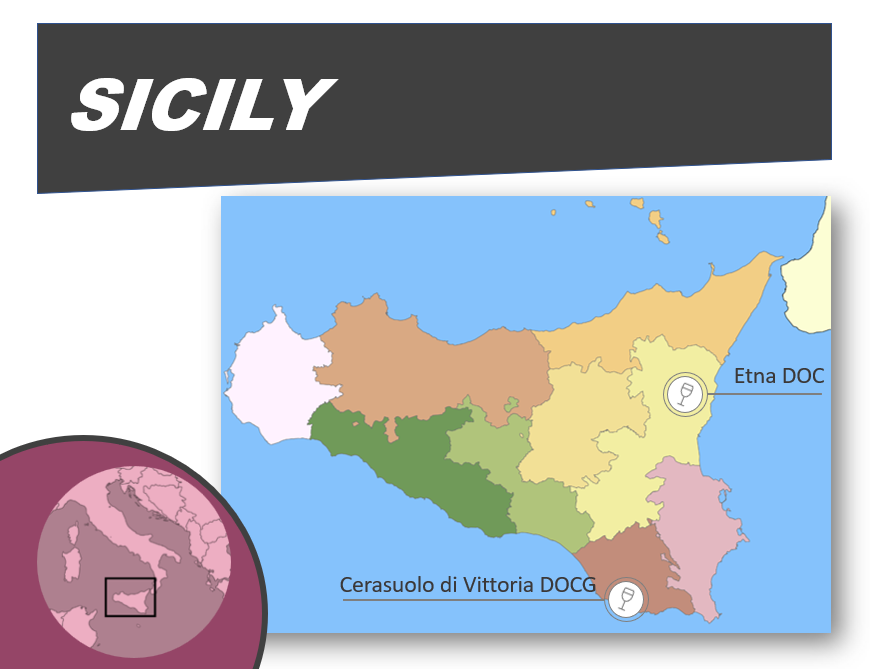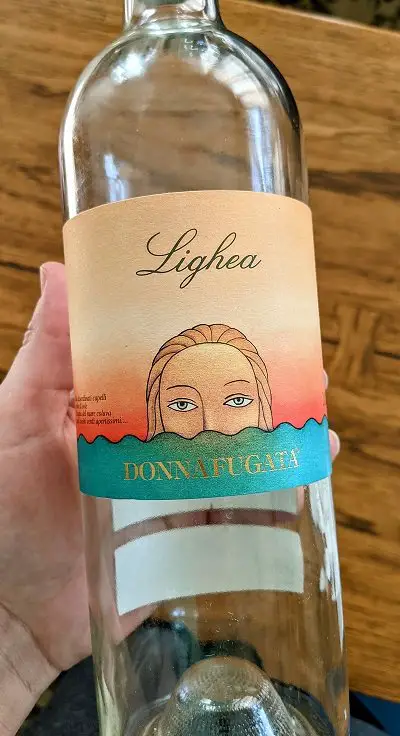
Humans ‘appeared’ on the island of Sicilia some 20,000 years ago, which my imagination interprets as **poof** a spontaneous apparition – and there we were! If you can believe it, grapes flourished on the island even before then. If ever there was a region suited to a wine culture, Sicilian wine has my vote.
Sicily produces a unique range of wines made from lesser-known native grape varieties, including white wines, red wines, dry wines, sweet wines, and even fortified Marsala. White wine grapes include Carricante, Catarratto, Grillo, and Minnella. Red wines from Sicily include Nero d’Avola, Nerello Mascalese, and Frappato. While much of Sicily’s grapes still go towards inexpensive, bulk wine production, smaller producers capitalize on the island’s rich volcanic soils from Mount Etna and old pre-phylloxera vineyards to craft noteworthy, exciting wines.
- What’s Special About Sicily?
- White Sicilian Wines
- Red Sicilian Wine Grapes
- Sicily’s Winegrowing Soils
- What Do You Need to Know About Sicily’s Wine Regions?
- Volcanic Wines from Sicily
- Not All Sicilian Wines Are Premium
- Thinking about a Sicilian Wine-Themed Tasting Event?
- Sicilian Wine Case Study: Lighea 2020
- Thirsty for More?
What’s Special About Sicily?

Dipped in the Mediterranean sea, the island of Sicily has been the hub of civilizations for millennia.
Home to the most active volcano in Europe, Mount Etna perches over the island and hums with the quiet purr of a sleeping cat. Without question, the dominant topographical and geological feature on Sicily is Mount Etna.
Ancient and modern cultures alike have woven the mythology of Mount Etna into their daily lives.
The Greeks had the legend of Hephaestus, whose workshop was located below the volcano; then came the Romans with Volcan, god of fire and metalworking. In more recent times, popular culture co-opted Volcan in Star Trek mythology, though I’d argue that the logic-loving aliens seem ill-fitted to the fiery temperament of molten lava.
Towering over the landscape at over 3,000 meters (+9,800 ft), Etna’s slopes are home to vineyards that enjoy the cooling effects of altitude in what would otherwise be a pummeling Mediterranean climate (it even has a glacier!).
Aside: To put this in perspective, some of the world’s highest-altitude vineyards nestled in the Argentinean Andes are around the same altitude.
White Sicilian Wines

- Carricante. Perhaps the most renowned white grape of Sicily, Carricante flourishes on the volcanic soils of Mount Etna DOC. Some claim that the grape’s called Mother Etna home for a thousand years. Carricante produces lively white wines with high acid and citrus. Carricante ripens slowly and may display herbal notes during cooler growing seasons.
- Catarratto. Not to be confused with Carricante (though it often is), Catarratto is native to Sicily and one of Italy’s most widely planted grapes. The grape is high-yielding, lending itself to bulk wine production for inexpensive white table wines. Catarratto finds itself as a frequent blending partner with Carricante and Grillo.
- Grillo. Grillo may be native to Sicily, or mainland Italy. This white grape plays a starring role in Marsala, but also crafts light, easy-drinking white wines when in the hands of a skilled winemaker. Unfortunately, the grape oxidizes easily (hence its popularity for fortified wines), but modern winemaking techniques have expanded the range of wine styles made with Grillo.
- Minnella. A native white grape of Sicily, this variety produces rich, tropical fruited wines with cinnamon and anise. Limited production makes this an obscure grape. The grape retains acidity for high-acid white wines.
- Zibibbo. Zibibbo is the local name for the aromatic white grape Muscat of Alexandria. Grown throughout the Mediterranean, Zibibbo produces deeply perfumed white wines with pronounced floral and grapey notes.
Red Sicilian Wine Grapes
- Nero d’Avola. Known locally as Calabrese, Nero d’Avola is a heat-loving black grape widely planted across Sicily. In fact, it’s the #1 black grape in Sicily. The wines can express jammy ripe plum and smooth tannins with chocolaty notes. If you enjoy Malbec, Nero d’Avola should be on your winetasting bucket list. Aside: Nero d’Avola has always been one of my favorite wine grapes, and I actually had a Nero d’Avola on my most recent blind tasting exam. I completely missed it – I just don’t drink enough of these wines. I should. You should, too.
- Nerello Mascalese. Grown on the slopes of Mt. Etna, Nerello Mascalese is a red wine grape in Sicily that makes earthy red wines dominated by red fruit – red cherry, raspberry, and red plum.
- Frappato. Frappato crafts light-bodied red wines that are similar to Beaujolais. Producers often blend Frappato with the more intense Nerello Mascalese.
Look for Sicilian red wines that include blends from Nerello Mascalese and Nerello Capuccio and bright white wines made from the Carricante grape.
Sicily’s Winegrowing Soils
Mount Etna covers the northeastern part of Sicily with some of the planet’s most diverse volcanic soils, creating unique, mineral-driven wines.
The volcanic soils have proven a boon to the island’s vineyards. Phylloxera, the root louse that all but destroyed Europe’s wine grape industry in the late 1800s, couldn’t survive in the volcanic terrain.
As a result, Sicily helped supply a thirsty Europe with wine through the early 1900s. Today, wine enthusiasts covet wines made from the old, own-rooted vines for their unique history and naturally low yields which increase a wine’s concentration and flavor.
On the western side of the island, soils are predominantly limestone and clay. The central portion of the island is a compilation of marine sedimentary rock and clay.
Then in the southeastern corner, limestone dominates, where the grape Nero d’Avola thrives.
What Do You Need to Know About Sicily’s Wine Regions?

If you’re looking for Sicilian wines, you have a few options.
First, there’s Sicily DOC. This DOC covers pretty much all of the grapes grown in Sicily – regardless of location. The blanket DOC intends to help elevate the visibility and status of wines coming out of Sicily.
You should know that mainstream – so called ‘international’ grapes can fall under the Sicily DOC label. A wine with Sicily may well be a Chardonnay or Cabernet Sauvignon.
Sicily DOC wines will likely be inexpensive to mid-priced wines of acceptable to good quality.
Look for: Sicily DOC on a label.
Jargon Alert. DOC stands for Denominazione di Origine Controllata (Denomination of Controlled Origin). Denominazione di Origine Controllata e Garantita (DOCG) is the highest quality level and sits above DOC wines.
The only DOCG (one level up from DOC) in Sicily is Cerasuolo Di Vittoria DOCG. Cerasuolo translates to ‘cherry red’, a nod to the wine’s color which comes from a blend of Nero d’Avola (between 50% and 70%) and Frappato (the remainder).
Fun Fact: Sicily is the home to not just wine and a wealth of historical sites, but also the birthplace of cosa nostra – the mafia.
The DOCG controls yields and requires wines to have a minimum of 13% alcohol. Vittoria refers to the province the DOCG calls home.
What I like about this particular wine, is that you know you’ll get a rich, ripe red wine that promotes two native grapes of Sicily. I imagine sipping on this glass in the evenings on a terraced patio overlooking the Mediterranean.
Look for: Cerasuolo di Vittoria DOCG on a label.
Volcanic Wines from Sicily

If you want volcanic wine, then go no further than Etna DOC. Imagine, continental growing conditions in the middle of the Mediterranean!
Grapes from the region grow on the north, east, and south-facing slopes of the Etna volcano on a range of volcanic soils deposited from countless eruptions through the ages.
The northernmost vineyards sit on ancient lava flows, which are thought to produce the most complex wines. Vineyards to the south sit on newer lava deposits.
Vineyards above 900 meters in altitude are the province of white wines. Red grapes thrive in the warmer altitudes of 300-800 meters.
Most wines from Etna DOC are blends.
Etna DOC wines meet the following requirements:
- Etna DOC Bianco: 60% Carricante, no more than 40% Catarratto. Can include up to 15% other non-aromatic grapes (e.g., like Minnella)
- Etna DOC Bianco Superiore: 80% Carricante, no more than 20% Catarratto or Minnella. Grapes must come from the Milo area.
- Etna DOC Rosso/Rosato: 80% Nerello Mascalese, no more than 20% Nerello Cappuccio/Mantellato. Can include up to 10% other non-aromatic red or white grapes.
- Etna DOC Spumante (Sparkling): 60% Nerello Mascalese, and up to 40% of other non-aromatic approved Sicilian varieties.
Look for: Etna DOC on the label.
Not All Sicilian Wines Are Premium
Sicily produces significant volumes of bulk wine. Some 80% of total production goes towards entry-level wines. The consistent Mediterranean climate and rich volcanic soils allow large producers to cultivate and vinify wines destined for the bulk market.
Historically, these bulk wines have played an important role in the Italian wine business.
Producers ship these wines to other cooler-climate regions across the country where the Sicilian wines add color, alcohol, and body to the local wines that are, perhaps shall we say, a little underwhelming.
This means that even if you haven’t intentionally sought out Sicilian wines, but do happen to drink Italian wines with any regularity, then it’s likely you’ve partaken in the island’s bounty.
Thinking about a Sicilian Wine-Themed Tasting Event?
The Godfather trilogy was partially filmed in Sicily. So go find a bottle or two of Sicilian wine and infuse yourself in the spirit of the island with an Al Pacino flick.
I indulged in the epic film The Leopard, a 3-hour saga shot on location in Sicily that covers the fall of the monarchy and transition to democracy in Italy. If you love Gone with the Wind or Casablanca, this 1963 masterpiece is for you.

Check out these other Sicilian cinematic masterpieces that will set the mood with your vino.
Sicilian Wine Case Study: Lighea 2020
Wine: Lighea, Zibibbo, 2020
Producer: Donnafugata

Price: ~$25 USD
Appearance: Pale Lemon
Pronounced Aroma: White flower notes, grape, fennel, lemon, peach
Dry, medium alcohol, high acid, medium (-) body, pronounced flavor intensity with grape, white flower, lemon, and peach, medium finish
Quality Assessment
This is a very good wine. The wine has a classic profile for the grape – Zibibbo – aka Muscat of Alexandria. Lovely floral notes with just a hint of sweet herbs and a crisp, mineral finish. The intensity of fruit flavors marries well with the wine’s high acidity, which could otherwise be overpowering and throw the wine off balance. The wine lacks a longer finish of a higher quality example, but I’m quite pleased for what the wine delivers. James Suckling gave the 2017/2018 a 91. The 2020 probably falls in that category, too.
Do not age this wine. Drink it now. On a sunny patio. While watching The Leopard.
Do you enjoy Sicilian wines? If so, what do you drink? Please share! This is a region I’d love to know more about.
Thirsty for More?
If you’re just getting into Italian wines, may I suggest exploring Friulano wines, a lesser-known white wine that will absolutely enchant you. You’ll find it right next to the Chianti in your local wine shop.
Here’s a post on Nebbiolo wines, Chianti’s northern neighbor, some of the most age-worthy Italian wines, and it’s fruity alternative, Barbera wines (if you love Pinot Noir, you’ll enjoy Barbera).
Check out this post on how to read Italian wine labels. DOC? DOCG? IGT?
If you’ve never tried Negroamaro, then you’re missing out on this delightful Italian red. Go find out why.




